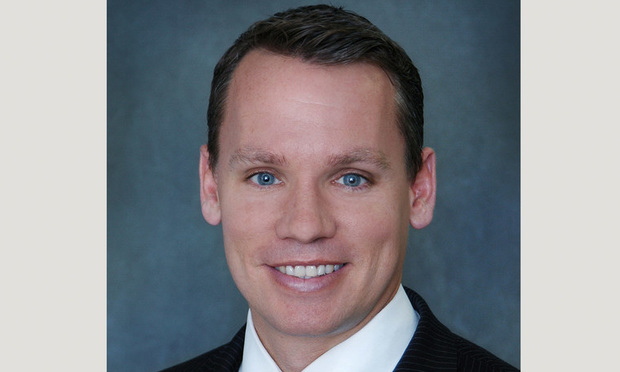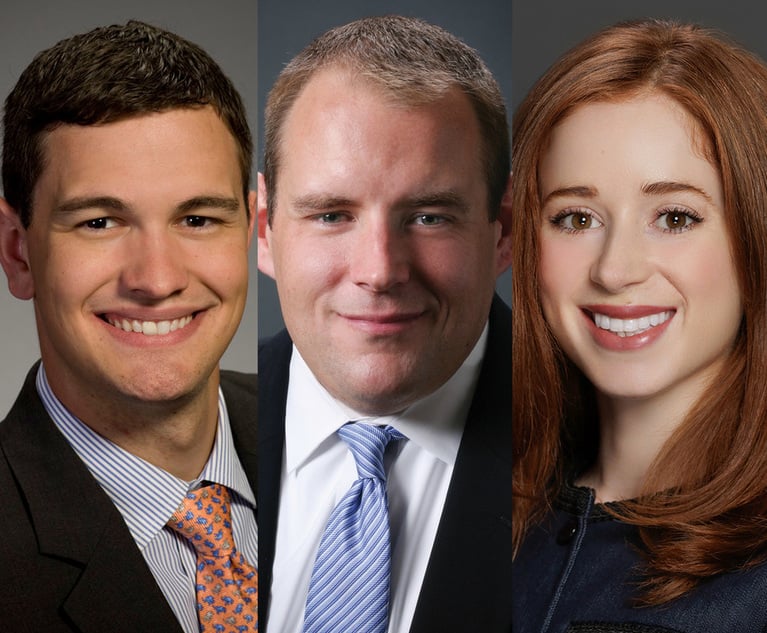Attention Copyright Owners: How Far Back Can You Claim Damages?
What if the copyright owner did not know that someone had been wrongly using the copyright for several years before the three-year limitations period? Does the owner waive those damages? Or, do the damages start with the initial infringement? The stakes can be considerable.
April 25, 2019 at 10:15 AM
10 minute read
 James Bryan, partner with Leon Cosgrove in Coral Gables, Florida.
James Bryan, partner with Leon Cosgrove in Coral Gables, Florida.
Copyright infringement usually happens over time, not all at once. A copyright owner typically discovers that someone has been expropriating protected work for several years. A key question for the owner is, how far back is the infringer liable for damages? The accepted wisdom has been three years. Under current copyright law, though, the answer is unclear. The U.S. Supreme Court should weigh conflicting opinions from lower courts and provide guidance to practitioners and judges.
What if the copyright owner did not know that someone had been wrongly using the copyright for several years before the three-year limitations period? Does the owner waive those damages? Or, do the damages start with the initial infringement? The stakes can be considerable.
In relevant part, the Copyright Act, 17 U.S.C. Section 504(b), provides that the “copyright owner is entitled to recover the actual damages suffered by him or her as a result of the infringement, and any profits of the infringer that are attributable to the infringement and are not taken into account in computing the actual damages.” Under 17 U.S.C. Section 507(b), the act states that “no civil action shall be maintained under the provisions of this title unless it is commenced within three years after the claim accrued.” Seems straightforward enough, but in application, it is not.
Federal courts in the U.S. Court of Appeals for the Eleventh Circuit (this practitioner's primary jurisdiction) generally hold that a cause of action accrues when the plaintiff learns, or a reasonable person should have learned, that the defendant was violating his rights (i.e., the discovery rule). See, e.g., Sieger Suarez Architectural Partnership v. Arquitectonica International, 998 F. Supp. 2d 1340, 1354 (S.D. Fla. 2014); Habersham Plantation v. Molyneux, Case No. 10-61526-CIV-DIMITROULEAS, 2011 WL 13216994, at *4 (S.D. Fla. Aug. 19, 2011).
Although the Eleventh Circuit has not squarely addressed the issue of whether the discovery rule applies to copyright suits, it appears to be the majority rule and has been cited in a concurring opinion in an Eleventh Circuit copyright case, see Calhoun v. Lillenas Publishing, 298 F.3d 1228, 1236 (11th Cir. 2002) (Birch, J., specially concurring) (“The limitations period may be triggered when a plaintiff knows or, in the exercise of reasonable diligence, should have known about an infringement.”), 539 U.S. 903 (2003).
Similar to the Eleventh Circuit, at least eight other circuits (the First, Second, Fourth, Fifth, Sixth, Seventh, Eighth and Ninth) appear to apply the discovery rule to civil actions under the Copyright Act. Complicating the matter, however, is that there appears to be a circuit split as to whether the discovery rule or the “injury rule” applies when a claim accrues under Section 507(b). The injury rule states that a claim accrues when the alleged infringement occurs, as opposed to when the plaintiff knows or should have known of the infringement.
Defendants accused of copyright infringement dating back more than three years from the filing of a complaint generally rely on the U.S. Supreme Court's decision in Petrella v. Metro-Goldwyn-Mayer, 572 U.S. 663, 667 (2014). Defendants refer to the language in that opinion that “a successful plaintiff can gain retrospective relief only three years back from the time of suit. … Profits made in those prior years remain the defendant's to keep.”
The problem with relying on Petrella to limit the scope of damages for copyright infringement based on the three-year statute of limitations, however, is that Petrella did not decide that issue. Petrella was about whether laches barred a lawsuit—not damages—brought within the three-year statute of limitations.
In Petrella, the defendant, who had invested in the movie “Raging Bull,” argued that the plaintiff had purposefully delayed bringing suit for many years despite knowing of her claim. Therefore, the plaintiff was barred by laches from suing after the defendant had made a substantial investment in the film.
Justice Ruth Bader Ginsburg, writing for the court, mentioned that a plaintiff can generally gain retrospective relief for only three years before the lawsuit was filed, and stated that a copyright claim accrues at the time of the infringing act.
In that same opinion, Ginsburg also noted the following:
Although we have not passed on the question, nine courts of appeals have adopted, as an alternative to the incident of injury rule, a “discovery rule,” which starts the limitations period when “the plaintiff discovers, or with due diligence should have discovered, the injury that forms the basis for the claim,” see William A. Graham v. Haughey, 568 F.3d 425, 433 (C.A.3 2009) (internal quotation marks omitted). See also 6 W. Patry, Copyright Section 20:19, p. 20–28 (2013) (hereinafter Patry) (“The overwhelming majority of courts use discovery accrual in copyright cases.”).
In Petrella, the issue was “whether the equitable defense of laches (unreasonable, prejudicial delay in commencing suit) may bar relief on a copyright infringement claim brought within Section 507(b)'s three-year limitations period.” The plaintiff had not sought relief for conduct occurring outside Section 507(b)'s three-year limitations period, and the Supreme Court ultimately held that laches “cannot be invoked to preclude adjudication of a claim for damages brought within the three-year window.” Thus, the Supreme Court did not decide whether the statute of limitations barred damages dating to before the three-year period.
About three years after Petrella, the Supreme Court had the opportunity in SCA Hygiene Products Aktiebolag v. First Quality Baby Products, 137 S. Ct. 954, 962 (2017) to clarify the rule, arguably mentioned in Petrella dicta, that a plaintiff can gain retrospective relief dating back from the statute of limitations period to the time of filing, and the defendant may keep profits made in those prior years.
The Supreme Court did not take advantage of the opportunity. In SCA Hygiene Products, the court first noted that it “returned to a subject it addressed in Petrella … [i.e.] the relationship between the equitable defense of laches and claims for damages that are brought within the time allowed by a statute of limitations.” Id. at 959. Similarly, the issue here was “whether Petrella's reasoning applies to a similar provision of the Patent Act [as opposed to the Copyright Act].”
Ultimately, the Supreme Court held that its reasoning in Petrella applied in the patent context as well. The court reiterated that in Petrella “we specifically noted that 'we have not passed on the question' whether the Copyright Act's statute of limitations is governed by [the discovery rule or the injury rule]”).
Since Petrella, most courts appear to reject arguments that damages beyond the three-year period are unavailable to copyright plaintiffs. For example, in Mitchell v. Capitol Records, 287 F. Supp. 3d 673, 676-77 (W.D. Ky. 2017), the defendants argued that the plaintiff should not be able to recover damages for infringements that occurred more than three years prior to filing suit. The defendants' argument was based on the statement in Petrella that a plaintiff can gain retrospective relief for only the three-year period.
The court rejected that argument, however, and noted Petrella made clear that the injury rule described there was not the only rule federal courts apply in copyright infringement cases.
Also, the Mitchell court noted that while “'the statute of limitations bars infringement claims that accrued more than three years before suit was filed,' a claim only 'accrues when a plaintiff knows of the potential violation or is chargeable with such knowledge.'” Accordingly, the court found the plaintiff was not precluded from recovering damages for any claims that occurred more than three years prior to commencement of the action.
See also Energy Intelligence Group v. Scotia Capital (USA), No. 16CV00617PKCKNF, 2017 WL 432805, at *2 (S.D.N.Y. Jan. 30, 2017) (stating that “under no reasonable reading of Petrella could the opinion be interpreted to establish a time limit on the recovery of damages separate and apart from the statute of limitations”); Lefkowitz v. McGraw-Hill Glob. Education Holdings, 23 F. Supp. 3d 344, 357 (S.D.N.Y. 2014) (considering Petrella and rejecting the defendant's contention that the injury rule, not the discovery rule, applies to federal copyright infringement claims); Grant Heilman Photography v. McGraw-Hill, 28 F. Supp. 3d 399, 411 (E.D. Pa. 2014) (considering Petrella and stating that the discovery rule is “the standard in nearly every circuit in the country); PK Music Performance v. Timberlake, No. 16-CV-1215 (VSB), 2018 WL 4759737, at *10 (S.D.N.Y. Sept. 30, 2018) (finding that many other courts have arrived at the same conclusion, that the discovery rule applies in copyright cases).
Other decisions hold differently. See, e.g, Papazian v. Sony Music Entertainment, No. 16 Civ. 07911, 2017 WL 4339662, at *4-5 (S.D.N.Y. Sept. 28, 2017). In Papazian, the defendant asserted that the plaintiff was not entitled to recover damages since each alleged act of infringement occurred more than three years before he filed his action. Contrary to other decisions in the Southern District of New York (cited above), the court in Papazian found that Petrella limited damages to three years before the filing date, even where the claim accrued according to the discovery rule.
Additionally, the Supreme Court appears to have again endorsed an injury rule-based approach (similar to Petrella) in the patent context based on its six-year statute of limitations. Without clear guidance from the Supreme Court on this issue, results probably will continue to vary.
Finally, this issue will likely raise its head sooner rather than later in copyright litigation, as plaintiffs seek damages discovery based on the date of the alleged first infringement, which may be several years earlier. Defendants will surely not want to search for and disclose information related to that first infringement.
In the experience of this practitioner, judges in the Eleventh Circuit will generally allow this discovery but will likely reserve determination as to the full extent of available damages until later in the litigation. Yet the full extent of available damages is a critical issue impacting strategic decisions including whether to accept reasonable settlement proposals based on the potential damages exposure known at that time.
In conclusion, it appears that the current weight of authority both before and after Petrella is that when a plaintiff discovers the infringement more than three years after it began, the plaintiff may recover damages from the first date of the infringement. That being said, some courts have reached a different conclusion.
Thus, the answer to the question of how far back a copyright owner can claim damages likely depends on the jurisdiction in which the case is brought, and more specifically, the judge handling the case.
The Supreme Court should craft an answer that applies everywhere.
James Bryan focuses on complex commercial litigation at Leon Cosgrove.
This content has been archived. It is available through our partners, LexisNexis® and Bloomberg Law.
To view this content, please continue to their sites.
Not a Lexis Subscriber?
Subscribe Now
Not a Bloomberg Law Subscriber?
Subscribe Now
NOT FOR REPRINT
© 2025 ALM Global, LLC, All Rights Reserved. Request academic re-use from www.copyright.com. All other uses, submit a request to [email protected]. For more information visit Asset & Logo Licensing.
You Might Like
View All
Leveraging the Power of Local Chambers of Commerce: A Second-Career Lawyer’s Guide to Building a Thriving Practice
5 minute read
CFPB Proposes Rule to Regulate Data Brokers Selling Sensitive Information
5 minute read
Essential Labor Shifts: Navigating Noncompetes, Workplace Politics and the AI Revolution

Initial Steps to Set Up a Fla. Appeal: Your Future Self (or Appellate Attorney) Will Thank You
6 minute readTrending Stories
Who Got The Work
J. Brugh Lower of Gibbons has entered an appearance for industrial equipment supplier Devco Corporation in a pending trademark infringement lawsuit. The suit, accusing the defendant of selling knock-off Graco products, was filed Dec. 18 in New Jersey District Court by Rivkin Radler on behalf of Graco Inc. and Graco Minnesota. The case, assigned to U.S. District Judge Zahid N. Quraishi, is 3:24-cv-11294, Graco Inc. et al v. Devco Corporation.
Who Got The Work
Rebecca Maller-Stein and Kent A. Yalowitz of Arnold & Porter Kaye Scholer have entered their appearances for Hanaco Venture Capital and its executives, Lior Prosor and David Frankel, in a pending securities lawsuit. The action, filed on Dec. 24 in New York Southern District Court by Zell, Aron & Co. on behalf of Goldeneye Advisors, accuses the defendants of negligently and fraudulently managing the plaintiff's $1 million investment. The case, assigned to U.S. District Judge Vernon S. Broderick, is 1:24-cv-09918, Goldeneye Advisors, LLC v. Hanaco Venture Capital, Ltd. et al.
Who Got The Work
Attorneys from A&O Shearman has stepped in as defense counsel for Toronto-Dominion Bank and other defendants in a pending securities class action. The suit, filed Dec. 11 in New York Southern District Court by Bleichmar Fonti & Auld, accuses the defendants of concealing the bank's 'pervasive' deficiencies in regards to its compliance with the Bank Secrecy Act and the quality of its anti-money laundering controls. The case, assigned to U.S. District Judge Arun Subramanian, is 1:24-cv-09445, Gonzalez v. The Toronto-Dominion Bank et al.
Who Got The Work
Crown Castle International, a Pennsylvania company providing shared communications infrastructure, has turned to Luke D. Wolf of Gordon Rees Scully Mansukhani to fend off a pending breach-of-contract lawsuit. The court action, filed Nov. 25 in Michigan Eastern District Court by Hooper Hathaway PC on behalf of The Town Residences LLC, accuses Crown Castle of failing to transfer approximately $30,000 in utility payments from T-Mobile in breach of a roof-top lease and assignment agreement. The case, assigned to U.S. District Judge Susan K. Declercq, is 2:24-cv-13131, The Town Residences LLC v. T-Mobile US, Inc. et al.
Who Got The Work
Wilfred P. Coronato and Daniel M. Schwartz of McCarter & English have stepped in as defense counsel to Electrolux Home Products Inc. in a pending product liability lawsuit. The court action, filed Nov. 26 in New York Eastern District Court by Poulos Lopiccolo PC and Nagel Rice LLP on behalf of David Stern, alleges that the defendant's refrigerators’ drawers and shelving repeatedly break and fall apart within months after purchase. The case, assigned to U.S. District Judge Joan M. Azrack, is 2:24-cv-08204, Stern v. Electrolux Home Products, Inc.
Featured Firms
Law Offices of Gary Martin Hays & Associates, P.C.
(470) 294-1674
Law Offices of Mark E. Salomone
(857) 444-6468
Smith & Hassler
(713) 739-1250






